How to combine cork flooring in the interior of an apartment
In the design of the premises, every detail matters: the coating of ceilings, walls, floors, physical properties and colors of the materials used. For floors, the most interesting solution is cork. A presentable appearance, natural beauty and warm shades of cork texture look great both in a modern interior and in a classic one. The cork flooring in the interior goes well with many other natural materials, such as bamboo, linen, reed or wood. No less spectacular is the combination of cork and glass textures, artificial stone, metal, which opens up great opportunities for creating author’s interiors.
Content
- What is a cork??
- Cork Benefits List
- Types of cork floors
- Cork – Health and Beauty
- Where can I put the cork on the floor?
What is a cork??
Cork is a specially treated bark of cork oak. It is crushed, heated at given temperatures and pressed. Bonded granules form a porous base. The internal structure of the cork determines its useful qualities, for which it was loved by master finishers and interior designers.
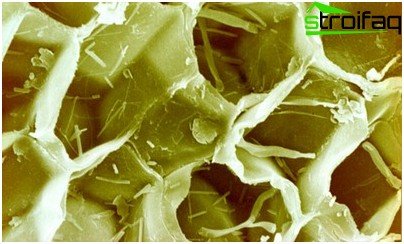
This is how the cell structure of the tube looks
The volume of the cork consists mainly of “empty” cells filled with gas and this creates a natural “foaming” of the material. It is she who provides such properties as elasticity, resilience, lightness, excellent heat and sound insulation, durability.
Cork Benefits List
By its qualities cork is a unique finishing material.
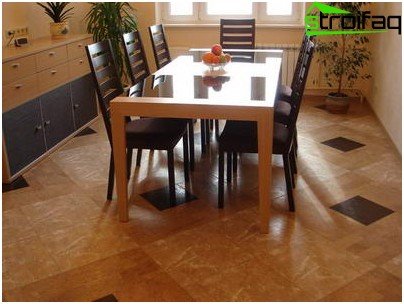
Cork goes well with wood
In addition to all the decorative properties, cork has a lot of functional advantages compared to other finishing materials:
- It is environmentally friendly because it is a natural material;
- It does not rot, is resistant to burning and solvents (these properties are provided by its complex of fats, lignin, wax, organic alcohols and acids);
- static electricity does not accumulate on its surface, so it does not collect dust;
- has high heat and sound insulating properties – it retains heat well and absorbs sounds;
- light: cork-finished construction is not loaded;
- after deformation, it easily restores its shape and volume – this is facilitated by its cellular structure;
- being a natural polymer, it has high elasticity.
In addition to the listed advantages, the cork is still very beautiful.
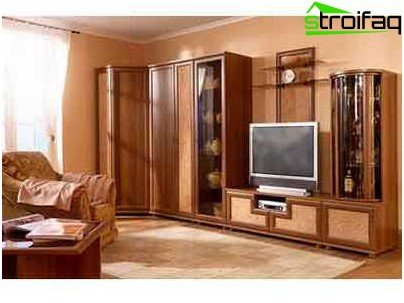
Cork coating will decorate any interior
Cork coverings for floors and walls will decorate any interior.
Types of cork floors
The variety of cork floors today is huge. In total there are about 40 shades, the shape of the flooring is quite diverse. According to the installation method, cork floors are divided into two main types – adhesive and floating.
Adhesive floors are square multilayer tiles, most often having dimensions of 300x300mm. The basis of such a tile is a pressed cork, which is coated on the front with a decorative cork veneer, the surface of which is protected by a transparent vinyl-based polymer. The veneer can have a natural color or be painted marble, granite or other natural materials..
Another type of cork adhesive floors are plates with dimensions of 900x150mm. Their front side is covered with veneer of trees of valuable species – walnut, cherry, pink oak, etc. The plate, respectively, costs more than cork tiles. Since the thickness of the tiles and plates is the same (3.2 mm) and their sizes are multiple, these two types of adhesive floors can be combined to create interesting unique compositions. Adhesive floors are installed mainly in large areas.
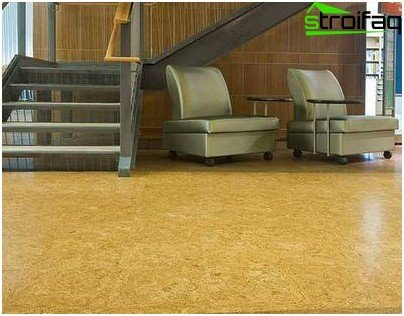
Adhesive cork floors are mainly installed in large areas.
Floating floors are available in the form of panels 900x185mm in size and 9mm thick. They have an additional layer of MDF, to the base of which a cork substrate is glued. Otherwise, their structure is the same as that of adhesive cork floor tiles. The “floating” floor does not stick to the base of the floor, but is fastened according to the principle of the puzzle – “spike-groove”. Joints of panels are glued with PVA glue, and such floors are laid easily, without preliminary preparation of the base (you can even install them on old parquet, linoleum or carpet).
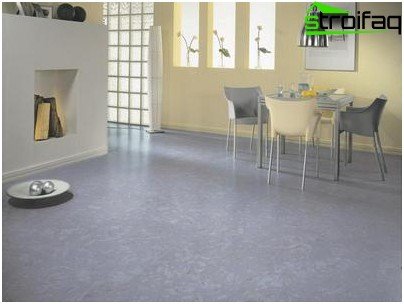
Environmentally friendly, hypoallergenic plug that does not collect static electricity – the best option for home improvement
Due to its ease of installation, floating floors are especially popular in residential areas..
Cork – Health and Beauty
Cork floors have become incredibly popular today. In addition to aesthetic appearance, they make the interior warmer and softer. It is pleasant to stand on cork floors, walk comfortably and quietly, sit comfortably or lie down, they are easy to care for. Every step on the cork floor preserves the health of the spine and joints.
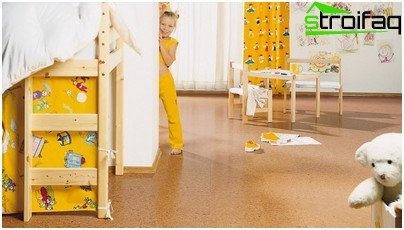
Cork in the children’s room is a very good solution, as the younger generation spends a lot of time sitting and playing on the floor
Where can I put the cork on the floor?
The unique texture of the cork emphasizes the beauty of the natural material. On the one hand, cork coating allows you to use the functional advantages of cork, on the other hand – visual (valuable wood species). Such a floor looks like parquet, but so soft and resilient, as if under it is a thick layer of rubber. Having good sound insulation, cork flooring – photos of various interior options presented in this article – will be the ideal solution for the room where the home theater is located or for the living room in which friendly feasts are held.
Since cork provides excellent thermal insulation and does not fade in the sun, it can be used on loggias and glazed balconies.

Cork flooring can be used on loggias and glazed balconies
And if you put cork not only the floor, but also the walls, the cold room will become not only more beautiful, but also much warmer.
As you know, cork has such qualities as resistance to decay, moisture resistance, does not grow moldy and does not allow pathogenic microflora to develop, it is not eaten by rats and mice. Based on this, cork floor can be safely put in the kitchen and in the bathroom.
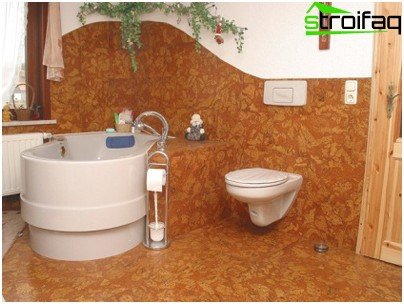
Cork flooring in the bathroom

Cork in the kitchen is a great solution!
Cork flooring – the photo is easy to color, while maintaining a rich natural pattern.
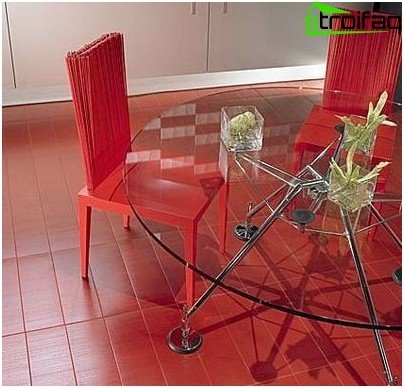
The painted cork gives originality and originality to the design of the room
The choice of bright, vibrant tones or delicate, pastel shades allows you to extremely diversify the interior. The current trend is cork bleaching, which in combination with milky furniture and light coarse textile creates an incredibly sophisticated look.
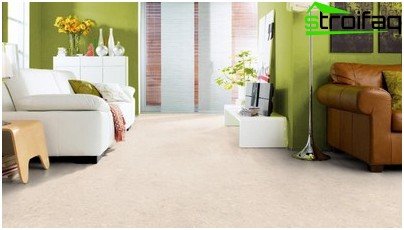
A sophisticated mix of bleached cork and dairy furniture
The options for combining the colors and textures of the cork floor in the interior are numerous and are limited only by the imagination of the designer.
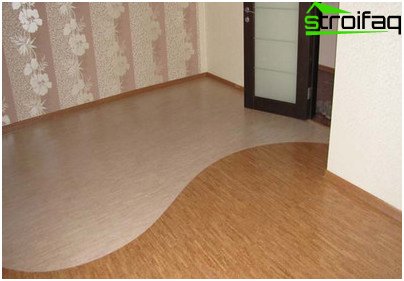
Design idea – a combination of cork flooring with different colors and textures
And whatever the style of decoration of your home, the cork floor will take pride of place in any interior.
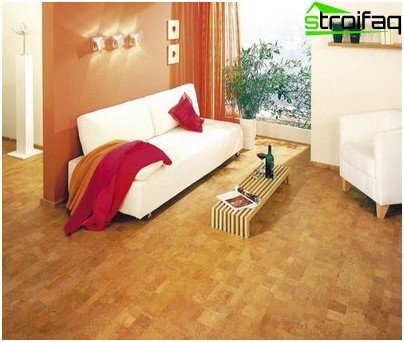
Cork flooring looks great in any style of interior.
Choosing a cork floor for your home, you will enrich its interior with natural paints, make the rooms cozy, warm and environmentally friendly..






